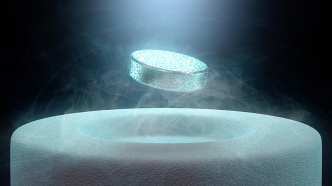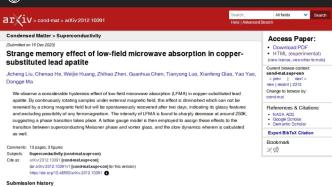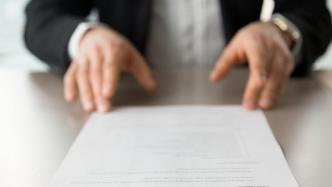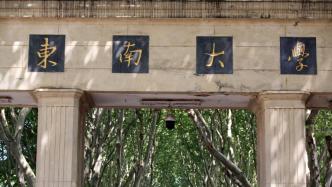
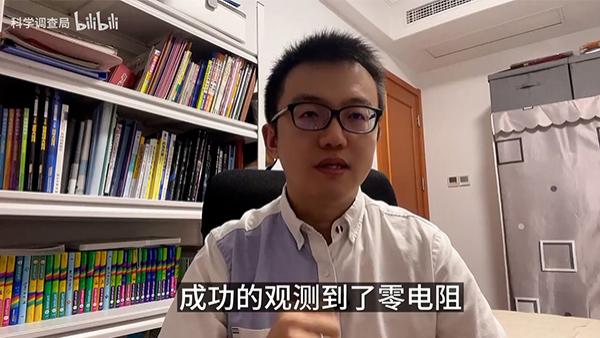
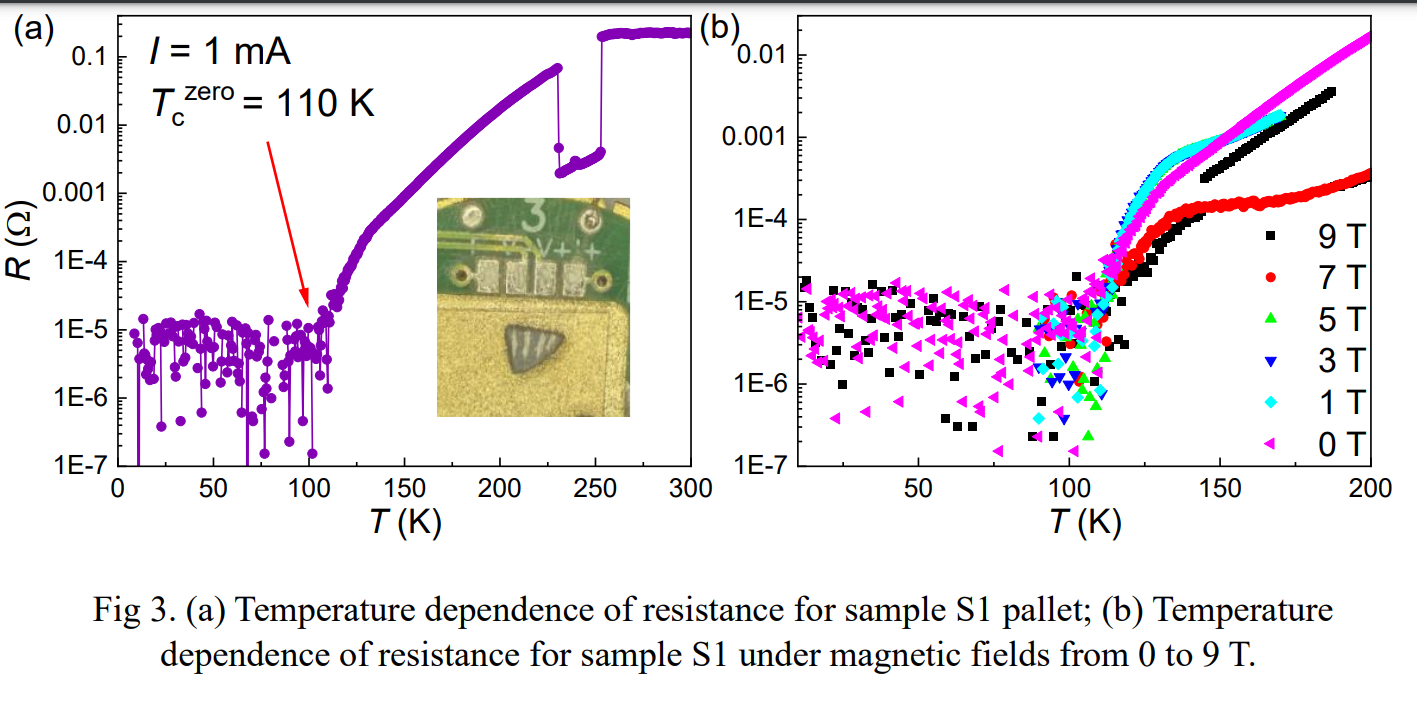
The relevant research team of Southeast University measured zero resistance in the LK-99 sample for the first time.
On August 2, another Chinese university research team, Professor Sun Yue and Professor Shi Zhixiang from Southeast University, completed repeated experiments on LK-99 materials and submitted a preprinted paper.
At least three preprinted papers on LK-99 from Chinese scientific research teams have been published, which were completed by relevant scientific research teams of the Institute of Metal Research, Chinese Academy of Sciences, Beijing University of Aeronautics and Astronautics, and Southeast University.
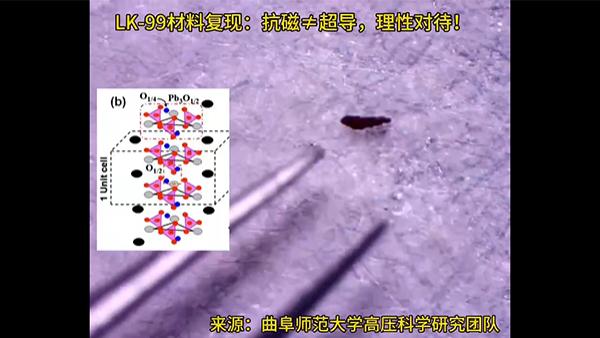
LK-99 is the world's first room temperature and pressure superconducting material announced by the relevant research team of the Korea Quantum Energy Research Center in two preprinted papers about a week ago - a copper-doped lead apatite material with a composition of Pb10-xCux(PO4)6O.
After the Korean scientific research team announced that LK-99 can be superconducting at room temperature, the relevant preprinted papers were published, and many laboratories at home and abroad followed up and verified it.
In the early morning of August 3, the research team of Southeast University announced for the first time the experimental results of the zero resistance of the LK-99 sample, but it was not at room temperature, but at 110K (-163.15°C, -273.15°C=0K), and there was no resistance magnetic. In other words, this LK-99 sample is not a room-temperature superconductor, nor is it any other superconductor.
Is LK-99 cold?
On August 3, a researcher who was conducting repeated experiments told Pengpai Technology, "At present, the material has not been reproduced 100%. Under the premise that the data of the Korean research team is true, only the preparation is the same as that described in their paper. In order to further verify whether it is a room temperature superconductor."
At 14:59 on August 2, Sun Yue, a professor and doctoral supervisor of the School of Physics of Southeast University, submitted a paper on the preprint website arXiv, saying that a polycrystalline sample of Pb10-xCux(PO4)6O was obtained using solid-phase synthesis technology. X-ray diffraction confirmed its structure consistent with reference. Under ambient pressure and at a temperature above 100K, the Pb10-xCux(PO4)6O sample is detected, and zero resistance is measured.
"Our findings suggest that Pb10-xCux(PO4)6O may be a candidate material in the search for high-temperature superconductors ," the paper said.
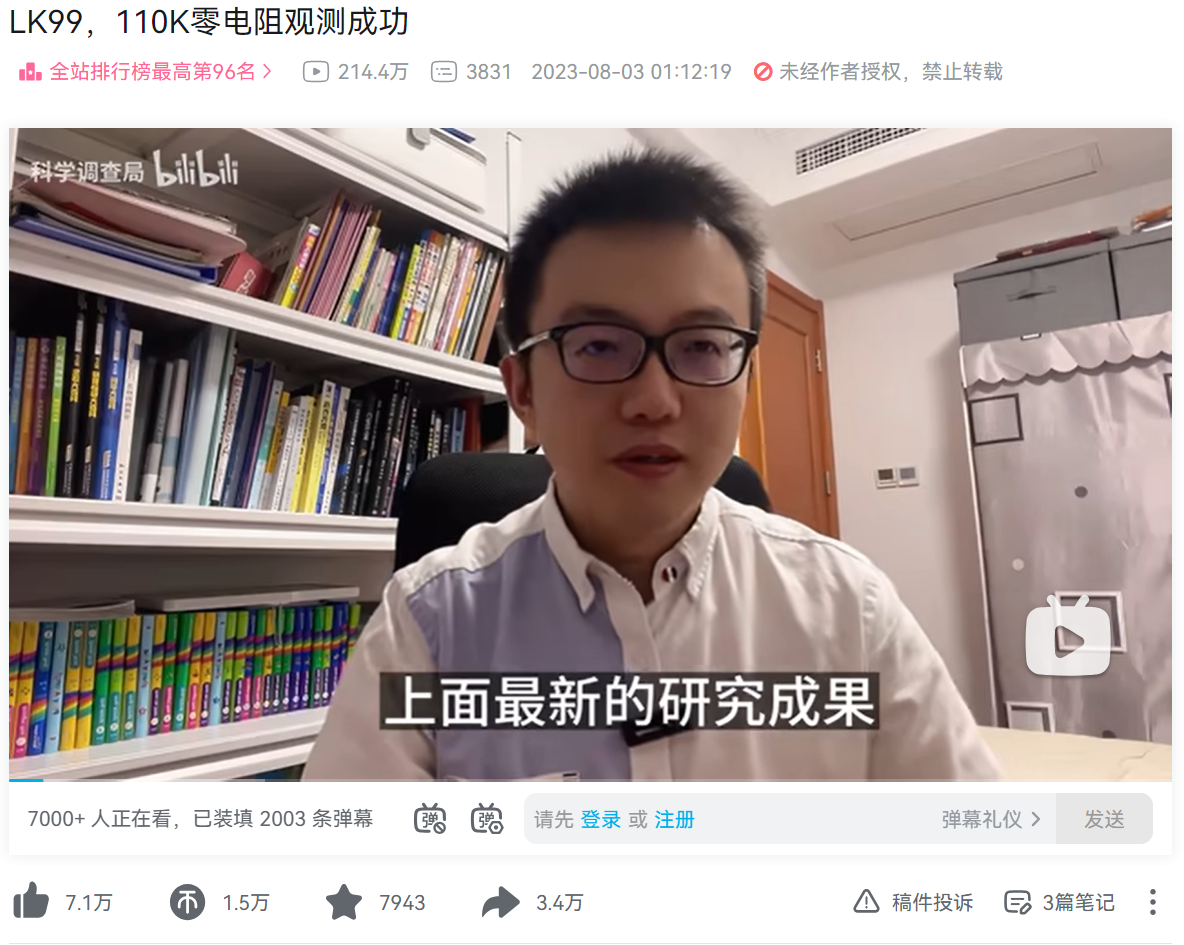
Professor Sun Yue from Southeast University said that a total of 6 samples were measured, but zero resistance was observed in only 1 sample, and most of the other samples produced semiconductor behavior. The screenshot is from the video released by the "Scientific Investigation Bureau" of the Up main "Scientific Investigation Bureau" of the Bilibili website (B station).
Subsequently, at 1:12 a.m. on the 3rd, Sun Yue posted a related explanation video on the domestic website Bilibili (Station B) - " LK99, 110K zero resistance observation was successful ", and commented, "It must be emphasized again, We measured zero resistance (extremely small resistance at the resolution limit of the instrument), but no diamagnetism, so we didn't say we were observing superconductivity."
Sun Yue said in the video, "It was on the afternoon of August 1 that we saw a steep drop in resistance similar to the superconducting transition , but at that time our resistance was less than 0, which had a very small value, so we later Intensified selection of samples”, a total of 6 samples were measured, but only 1 sample was observed to have zero resistance, and most of the other samples produced semiconductor behavior.
Then, they measured the Meissner effect on the aforementioned sample with zero resistance observed, "It is a complete diamagnetic measurement, but we did not observe this complete diamagnetic measurement in the magnetic measurement, so we guessed that the If the zero resistance is caused by superconductivity, its superconducting component should be relatively low." Sun Yue said.
At the end of the video, Sun Yue said, "We successfully observed zero resistance at 110K under the LK-99 material, but this is not evidence of room-temperature superconductivity. Whether it has room-temperature superconductivity remains to be further explored." And measurement , our team will continue to work hard in this area and hope to have better results to report to you.”
The aforementioned paper stated that " the Meissner effect was not observed in our samples... We still need more evidence to confirm superconductivity and to determine which component is responsible for zero resistance (superconductivity). Furthermore, the critical temperature Whether (Tc, the superconducting transition temperature) can be raised to room temperature is still an open question."
In this regard, some netizens commented that the experimental sample did not detect diamagnetism, but it can have zero resistance at a temperature of 110K, but the sample from Qufu Normal University is diamagnetic, but the resistance is very large, and it is almost non-conductive. So, what material is LK-99?
According to the information released by the Institute of Physics of the Chinese Academy of Sciences, generally speaking, superconductors with a critical temperature higher than 40K are called high-temperature superconductors, and superconductors with a critical temperature higher than about 300K are called room-temperature superconductors. In other words, in the world of superconductivity, "room temperature" is actually much higher than "high temperature".
Earlier, on August 1, the relevant scientific research team of Huazhong University of Science and Technology released a video about the repeated experiment of LK-99 material on the domestic website Bilibili (Station B), which became popular on social media at home and abroad. The video shows that the LK-99 sample synthesized by the research team led by Professor Chang Haixin from the School of Materials Science and Engineering of Huazhong University of Science and Technology can stand upright under the action of a magnet, and the angle of "suspension" of the sample is larger than that of the Korean team's sample , but the resistance of its samples has not been determined.
On August 3, The Paper learned from relevant persons of Qufu Normal University that the research team led by Professor Liu Xiaobing and Associate Professor Xing Xiangzhuo of the School of Physics and Engineering of Qufu Normal University synthesized the LK-99 sample and found that it can also stand upright under the action of a magnetic field. ", but its room temperature resistance is not zero. At present, the second batch of samples has been "fired" and has not yet been tested.
In addition, at 18:04 on July 29, Liu Peitao, a researcher at the Institute of Metal Research, Chinese Academy of Sciences, submitted a paper on the preprint website arXiv. According to the paper, according to theoretical calculations, LK-99 has a unique electronic structure and the possibility of room temperature superconductivity; compared with silver, gold exhibits a doping effect more similar to copper.
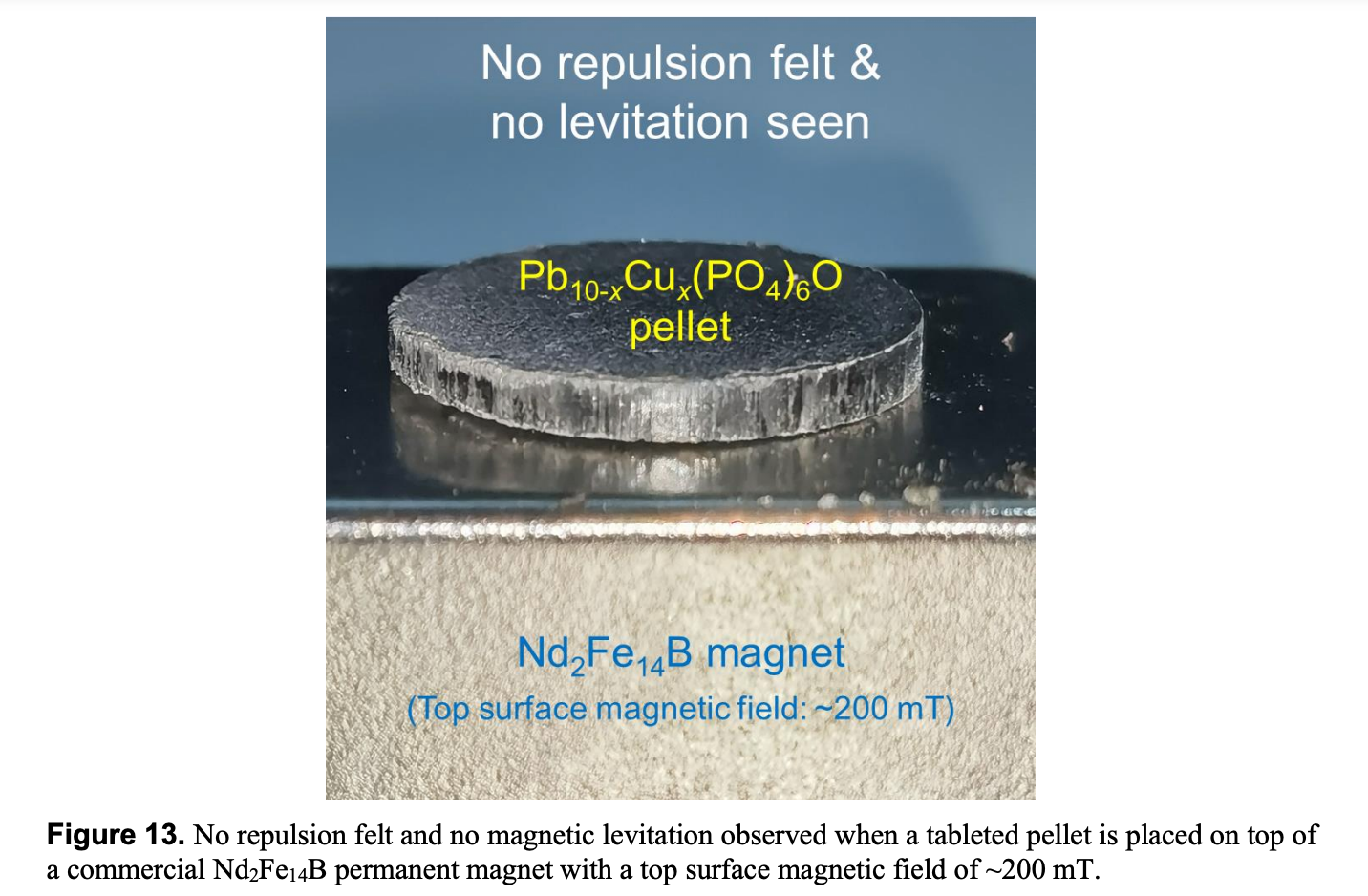
The research team of Beihang University found in repeated experiments that the sample was placed on a permanent magnet, but no repulsive force was detected and no magnetic levitation phenomenon was observed.
At 16:13 on July 31, the team of Professor Liu Zhiqi from the School of Materials Science and Engineering of Beihang University submitted a paper on the preprint website arXiv. According to the paper, the room temperature resistance of the LK-99 sample is not zero, and no magnetic levitation phenomenon has been observed; the material is similar to a semiconductor, not a superconductor.
According to previous reports from The Paper, on the morning of July 22, the relevant research team of Korea Quantum Energy Research Center submitted two similar papers on the preprint website arXiv, claiming that a copper-doped lead phosphor named LK-99 Stone materials have "room temperature + normal pressure" superconducting ability. However, the experimental data released so far are considered by industry insiders to be insufficient to prove that LK-99 is a superconductor.
Subsequently, a number of international research teams began to repeat experiments, attempting to synthesize LK-99 in order to reproduce the experimental results of the Korean team. Related news also had a greater impact on global stock markets.
Attached paper link:
1. Korean paper 1: https://arxiv.org/abs/2307.12008
2. Korean paper 2: https://arxiv.org/abs/2307.12037
3. Papers of Beihang University: https://arxiv.org/abs/2307.16802
4. Papers from the Institute of Metal Research, Chinese Academy of Sciences: https://arxiv.org/abs/2307.16040
5. Lawrence Berkeley National Laboratory paper: https://arxiv.org/abs/2307.16892
6. Southeast University paper: https://arxiv.org/abs/2308.01192
7. Video of Sun Yue introducing the experimental results: https://www.bilibili.com/video/BV1pM4y1p7u5/?spm_id_from=333.337.search-card.all.click
